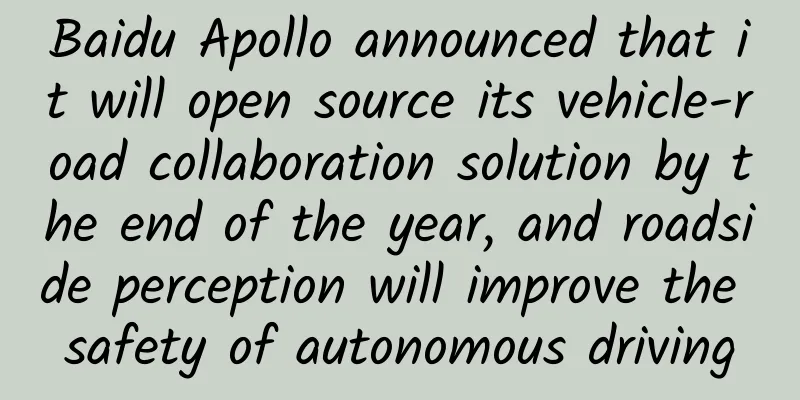Baidu Apollo announced that it will open source its vehicle-road collaboration solution by the end of the year, and roadside perception will improve the safety of autonomous driving

|
On September 14, Li Zhenyu, Vice President of Baidu and General Manager of the Intelligent Driving Business Group, announced at the "Baidu Apollo Media Communication Conference" that the Apollo vehicle-road collaboration solution will be officially open sourced at the end of 2018, opening Baidu Apollo's technology and services in the field of vehicle-road collaboration to the industry. It is reported that Baidu began to develop the full stack of "vehicle-road collaboration" in 2016. As of now, Apollo has scenarios in various regions such as Beijing, Xiongan, and Silicon Valley; a variety of vehicle models such as passenger cars, driverless minibuses, and unmanned logistics vehicles; it also develops leading vehicle-road collaboration full-stack technology in roadside perception sensor solutions, roadside perception algorithms, vehicle-side perception fusion algorithms, data compression and communication optimization, V2X terminal hardware and software, and V2X security; in addition, Apollo's unmanned vehicle fleet, open road unmanned vehicle test mileage and other series of scenario data accumulation have laid the foundation for Baidu's layout of vehicle-road collaboration. Li Zhenyu said that the official open source of the Apollo vehicle-road collaboration solution marks that the Apollo open platform has entered a new stage of overall open source of the vehicle and road sides. Baidu's autonomous driving technical director Tao Ji shared Baidu's key insights into the field of vehicle-road collaboration, which requires a three-pronged approach from the vehicle side, road side, and communication link, and vehicle side experience is particularly important. Only through multi-scenario practice on the vehicle side can more precise requirements be put forward for the accuracy of roadside perception equipment and the efficiency of communication links, and the actual effect of information feedback from roadside equipment can be verified. Apollo's open source of vehicle-road collaboration will add or upgrade vehicle-road collaboration related modules in software, hardware, cloud services, etc. on the basis of the existing four-layer open technology framework of the Apollo open platform. At the reference hardware layer, Apollo will add reference hardware on the vehicle side and the road side to complete the information transmission and analysis between the autonomous driving vehicle and the road side. At the open source software layer, Apollo has upgraded the perception and decision-making planning modules, which can complete the fusion processing of the Apollo system's vehicle-side information on the V2X-related information of the vehicle-road collaboration; at the same time, it provides a software package that can run on the vehicle-side and roadside reference hardware, responsible for the relevant preprocessing of V2X information. At the cloud service layer, it opens up intelligent roadside services, provides information such as roadside perception prediction required for autonomous driving, and at the same time opens up algorithms such as roadside perception prediction; it upgrades simulation service capabilities and expands simulation scenarios in the vehicle-road collaboration environment. Taking an intersection with complex traffic conditions as an example, human drivers and self-driving car sensors can only perceive part of the road condition information due to the limitations of perspective and line of sight. Invisible obstacles pose a hidden danger. If the vehicle-road collaboration is equipped with a "perfect perspective" roadside perception device, it can use a variety of sensors such as high-definition cameras and the computing and recognition capabilities of Baidu Brain to perceive all traffic participants within the intersection and realize a variety of analysis functions. This information can be shared in real time with all vehicles at the intersection through V2X communication, thereby eliminating hidden dangers to the greatest extent. It is estimated that vehicle-road collaboration can help solve 54% of the problems encountered by single-vehicle intelligence in road tests and reduce the number of single-vehicle intelligent takeovers by 62%, which is equivalent to adding a layer of redundant protection for the safety of autonomous driving. In the past, "communications manufacturers were not familiar with the needs of autonomous driving, it was not easy for autonomous driving manufacturers to obtain emerging communication technology services, and road equipment manufacturers were not good at AI algorithm research and development." Car-road collaboration was like "blind men touching an elephant." But to develop car-road collaboration, we must embrace smart cars and smart roads at the same time. In the future, Baidu will share the actual experience and capabilities accumulated in a large number of autonomous driving road tests by open-sourcing its own car-road collaboration solution, so that partners involved in the development of car-road collaboration can truly walk on two legs. On the same day, Baidu also announced that it would cooperate with Datang Telecom Group, TransInfo, China Unicom and other enterprises based on the powerful ecological capabilities of the world's leading Apollo open platform to integrate resources from various sectors such as automobile manufacturing, transportation infrastructure equipment manufacturing and integration, communications, chips, government and universities to jointly develop a vehicle-road collaborative system. Baidu will also cooperate with Xiongan New Area to conduct trials first and further explore new paths for the development of vehicle-road collaborative transportation. At the same time, a joint laboratory will be established with Tongji University to carry out in-depth cooperation in the planning and design of unmanned vehicle road networks and traffic flow simulation. As a winner of Toutiao's Qingyun Plan and Baijiahao's Bai+ Plan, the 2019 Baidu Digital Author of the Year, the Baijiahao's Most Popular Author in the Technology Field, the 2019 Sogou Technology and Culture Author, and the 2021 Baijiahao Quarterly Influential Creator, he has won many awards, including the 2013 Sohu Best Industry Media Person, the 2015 China New Media Entrepreneurship Competition Beijing Third Place, the 2015 Guangmang Experience Award, the 2015 China New Media Entrepreneurship Competition Finals Third Place, and the 2018 Baidu Dynamic Annual Powerful Celebrity. |
Recommend
Smart driving for all, the ultimate king bomb! The second-generation Yuan PLUS Smart Driving Edition starts at 115,800 yuan and has been reduced in price!
On March 5, BYD's second-generation Yuan PLUS...
What is the difference between unemployment insurance and unemployment benefits? Can they be received at the same time?
Friends who participate in social security during...
Aiti Tribe Stories (24): Rooted in the technology circle, with a strong sense of belonging
[51CTO.com original article] The protagonist of t...
Talking nonsense when confused: Is this a "mysterious performance" in the brain theater?
Audit expert: Chen Mingxin National Level 2 Psych...
A collection of three seasons of the web drama "College Students Living Together"
The play is based on one of the controversial topi...
France closes all schools! How long will it be closed? Will transportation be open?
At 8 p.m. on March 12, French President Macron de...
In the marketing battle of Double Eleven, how does JD.com advance step by step? Lulingzi Village
As Papi Jiang said, the only thing that prevented...
The core ideas and 14 practical methods of Weibo promotion
Weibo promotion uses Weibo as a promotion platfor...
Review! Alipay's promotional tactics of sending 1 billion red envelopes
After the amazing copywriting of Alipay red envel...
The maximum discount of "Deyuanlang" is up to 30,000, but the 1.6L model is still not the best choice
Among the netizens, Lavida has always had a nickn...
How does online education build a private traffic system?
Traffic costs are becoming more and more expensiv...
Vomit everywhere at popular tourist spots! A kind of candy is hot on the Internet, don't buy it or eat it →
Recently, there have been many gray-black oil sta...
How much does it cost to attract investment for the Linfen Fruit Mini Program? What is the investment price for Linfen Fruit Mini Program?
Linfen Fruit Mini Program investment promotion is...
Tesla's domestic production is finalized and will be put into production in 2020
As a huge consumer market for electric vehicles, ...
WeChat Moments now supports posting emoticons and setting friend permissions: chat only
On December 23, iOS WeChat 7.0.9 was updated. The...









